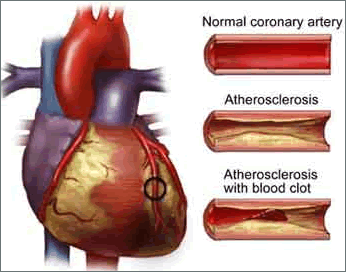Late
Antiretroviral Therapy Raises Risk of Early Atherosclerosis
 |
 |
 |
 |
 |
 |
 |
| SUMMARY:
Starting antiretroviral therapy (ART) early, before
CD4 cell count falls below 350 cells/mm3, may reduce
the risk of stiffening of the arteries, an early sign
of atherosclerosis that can lead to heart attacks, according
to a University of California at San Francisco (UCSF)
study described in the June
9, 2010 advance online edition of AIDS. |
|
 |
 |
 |
 |
 |
 |
 |
By
Liz Highleyman
Large observational studies have found that people with HIV
have a higher likelihood of cardiovascular disease and heart attacks
compared with the general HIV negative population. The reason
for this is not fully understood, but inflammation and metabolic
changes related to antiretroviral
drugs appear to play a role.
Jennifer Ho and colleagues from Steven Deeks' team at UCSF, which
has done extensive work on HIV-related inflammation and its consequences,
looked at whether earlier initiation of HIV treatment might reduce
cardiovascular risk related to atherosclerosis. Findings were
previously presented in part at the 17th Conference on Retroviruses
and Opportunistic Infections (CROI) this past February.
As
atherosclerosis progresses, arteries lose their elasticity, or
ability to expand, as they become filled with plaques made up
of lipids, immune cells, and other material. Eventually this blockage
can impair blood flow, and pieces of plaque or blood clots can
break away and become lodged in vessels supplying the heart (causing
a heart attack) or the brain (causing a stroke).

The present analysis included 80 men, with a median age of 47
years, from the UCSF SCOPE cohort (who started ART during chronic
infection) and the OPTIONS study (who started ART during acute
infection, within 6 months after HIV exposure). About 80% had
started therapy with a nadir (lowest-ever) CD4 T-cell count below
350 cells/mm3, the treatment guidelines threshold for ART initiation
in effect at the time of the study.
All participants had undetectable viral load at the start of the
study. The late starters had a lower nadir CD4 count (85 vs 494
cells/mm3) and current CD4 count (459 vs 785 cells/mm3) than the
early starters. Traditional cardiovascular risk factors including
smoking and high blood pressure were common.
Participants
underwent non-invasive assessment of arterial stiffness using
pulse wave analysis (to determine the augmentation index, normalized
for a heart rate of 75 bpm) and carotid-femoral pulse wave velocity,
2 sensitive measures of cardiovascular risk.
The investigators used these data to determine the relationship
between arterial stiffness and cardiovascular and HIV-related
factors. The analysis was adjusted for cardiovascular risk factors
including age, smoking, blood pressure, use of antihypertensive
(high blood pressure) medication, diabetes, and elevated cholesterol.
Results
 |
In
an unadjusted analysis, predictors of worse arterial stiffness
included older age, high blood pressure, use of antihypertensive
drugs, and nadir CD4 count below 350 cells/mm3 (all P <
0.05). |
 |
After
adjusting for cardiovascular risk and HIV-related factors,
having a nadir CD4 count below 350 cells/mm3 was independently
associated with greater arterial stiffness: |
| |
 |
7.3%
increase in augmentation index (P = 0.003); |
 |
0.41
m/s increase in pulse wave velocity (P = 0.03). |
|
 |
Neither
duration of ART nor use of protease inhibitors, however, were
associated with arterial stiffness. |
Based
on these findings, the investigators concluded, "Among treated
HIV-infected individuals, arterial stiffness is independently
associated with both traditional cardiovascular risk factors as
well as a low nadir CD4 T-cell count."
"Our data suggest that cardiovascular risk among HIV-infected
individuals could be reduced through early initiation of antiretroviral
therapy, before CD4 T-cell counts are depressed, a concept that
should be tested prospectively in future studies," they added.
Investigator affiliations: Division of Cardiology and Positive
Health Program, San Francisco General Hospital, San Francisco,
CA; Department of Epidemiology and Biostatistics, University of
California at San Francisco, San Francisco, CA.
7/9/10
Reference
JE Ho, SG Deeks, FM Hecht, and others. Initiation of antiretroviral
therapy at higher nadir CD4+ T-cell counts is associated with
reduced arterial stiffness in HIV-infected individuals. AIDS
(Abstract).
June 9, 2010 (Epub ahead of print).
